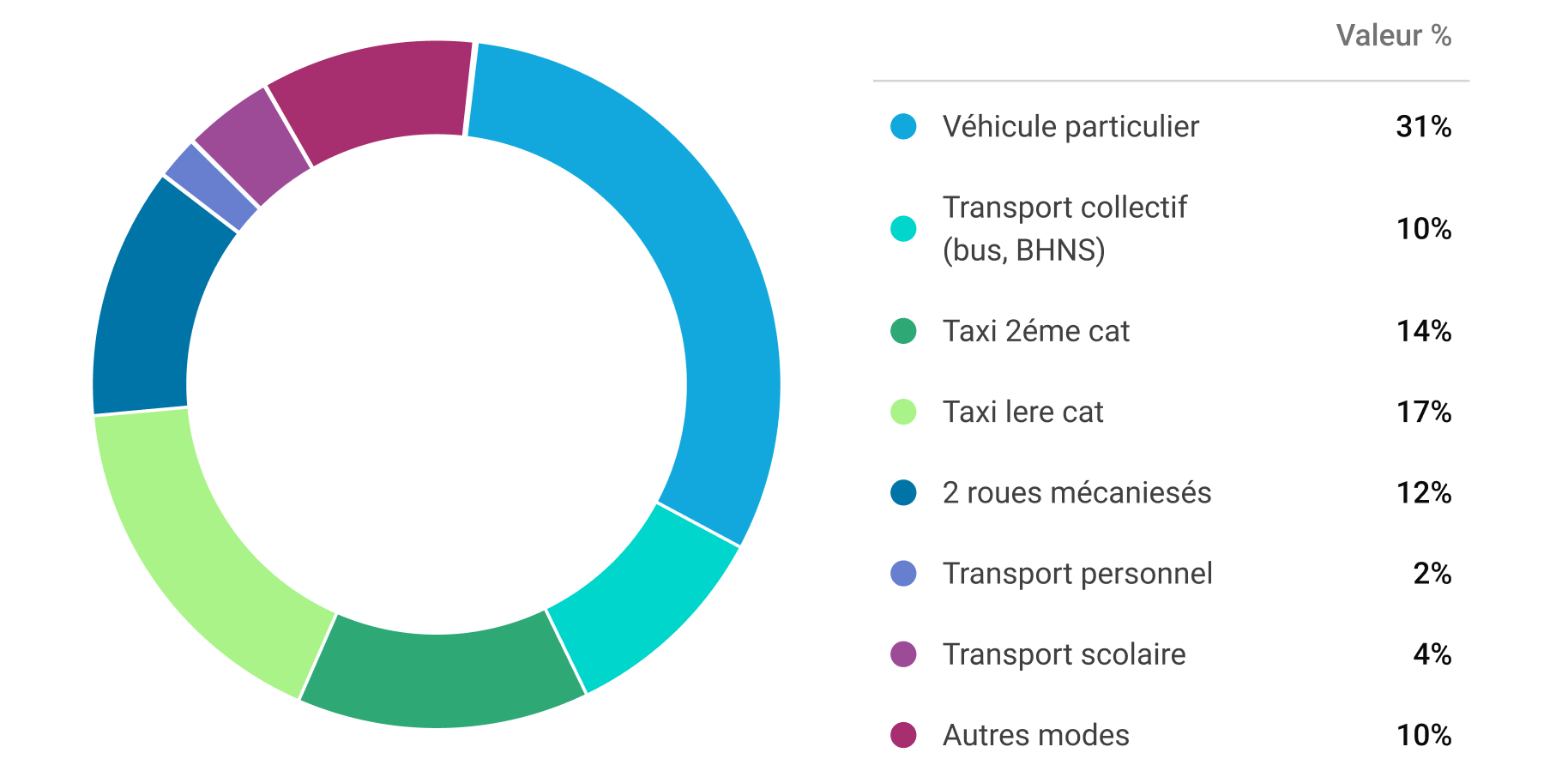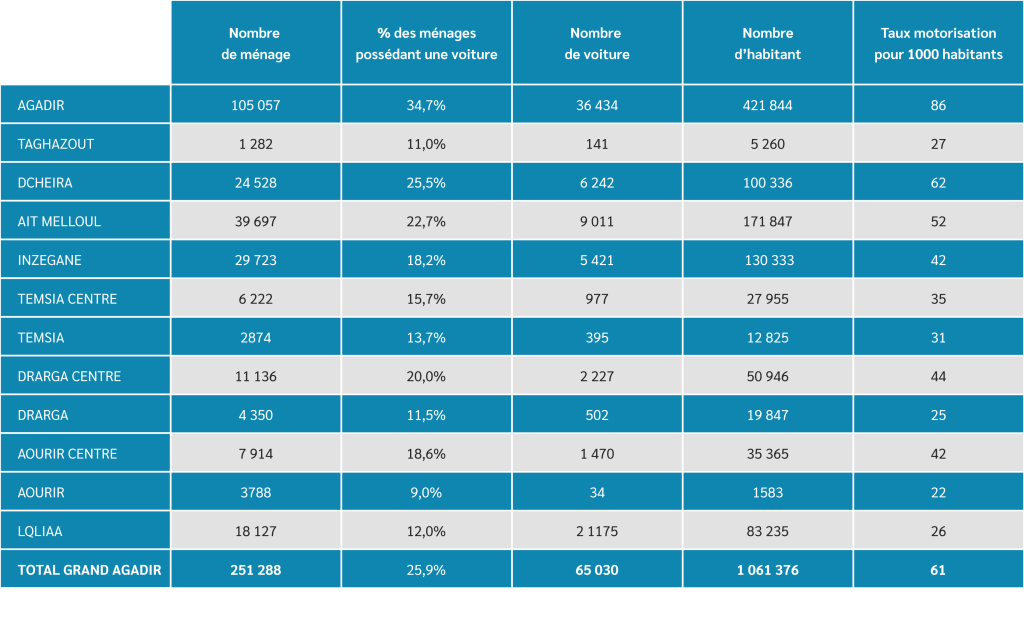Conducted between 2013 and 2015, the diagnostic study of the Urban Mobility Plan for Greater Agadir provided an overview of the mobility of Agadir residents and transportation infrastructure in terms of supply and demand.
Key Mobility Indicators in Agadir
Number of Trips and Modal Distribution:
According to the household travel survey (EMD) conducted in 2010 and adjusted by the PDU study in 2013, the residents of Greater Agadir make nearly 3 million trips per day, with almost half of them made by non-motorized modes, primarily walking (48%). Private cars lead among mechanized modes of transport (31%), followed by grand taxis (16%), small taxis (13.5%), and then buses (10%).

Motorization Rate
According to the Urban Mobility Plan (PDU) diagnosis, a large proportion of households do not own a car, representing 72% of all households in Greater Agadir. Car ownership varies between municipalities, with non-motorized populations mainly residing in Taghazout, Aourir, and Drarga, while the majority of motorized households are concentrated in central Agadir, Hay Mohammadi, and Tikiouine.
Based on this data, the motorization rate defined by the PDU was 0.32 vehicles per household on average, amounting to a total of 67,000 cars, which was considered relatively low. An update of the motorization rate, based on the 2014 census data, showed the proportion of households owning a car in each municipality of Greater Agadir.
Findings indicate that the total number of cars in Greater Agadir was approximately 65,000, with 55% of them located in the city of Agadir—around 36,430 cars. This corresponds to a motorization rate of 86 cars per 1,000 inhabitants in 2014.
Assuming that a maximum of 5% of households own two vehicles, the motorization rate rises to about 91 cars per 1,000 inhabitants. However, this rate remains relatively low compared to other Moroccan cities, such as Casablanca (101 cars per 1,000 inhabitants, EMD 2018) and Marrakech (120 cars per 1,000 inhabitants, EMD 2008).

The diagnosis also analyzed the infrastructure dedicated to each mode of transport and compared it with actual usage patterns. The key mobility characteristics in Greater Agadir, as identified by the Urban Mobility Plan (PDU), are as follows:
Mobility Flow
- The center of Agadir serves as the main hub for both attracting and generating motorized traffic flows. The strongest traffic routes are those connecting nearby districts, particularly Hay Mohammadi, which records nearly 25,000 trips per day, as well as Dcheira, Bensergao, Inezgane, Aït Melloul, and Tikiouine.
- The port of Agadir is also a major traffic generator, especially in connection with Anza and the city center.
- Beyond Agadir’s city limits, Inezgane, particularly its commercial zone, stands out as the second-largest hub for motorized traffic flows in Greater Agadir, following Agadir-Center. It is strongly linked to Aït Melloul, Dcheira, and Inezgane
- Motorized travel flows under 5,000 trips per day are spread across the entire territory, with both short- and long-distance routes. In addition to the previously mentioned hubs, the port and the university district are among the top generators of traffic.
Road Traffic
- Lack of infrastructure to differentiate between national transit traffic and local traffic: National roads RN1 and RN10 handle both north-south transit flow and local traffic within Greater Agadir.
- Discontinuity in the road network, abrupt changes in road characteristics, and gaps in connectivity cause congestion and accessibility issues in key areas.
- Intersection saturation on main roads during peak hours, mainly due to poor planning or ineffective traffic management at intersections.
- Congestion issues are concentrated on main roads such as RN1, RN10, and the East-West link, as well as certain secondary roads in the city center like Avenue Bouabid and Avenue Hassan I. The main causes include:
- Lack of road-sharing regulations according to each road’s function.
- Illegal parking and encroachment on public space.
- Poor intersection management, leading to traffic buildup.
Parking
- High parking demand near workplaces, commercial attractions (beach areas, Souk El Had, etc.), and major traffic hubs (port, university district, public facilities).
- Lack of parking management and enforcement leads to traffic congestion.
- Shortage of residential parking spaces.
- Parking plays a key role in managing traffic flow efficiently. Regulating parking conditions (either restrictive or incentive-based measures) near major hubs is essential.
Active Mobility (Walking & Cycling)
- Despite high pedestrian activity, pedestrian infrastructure lacks continuity, comfort, and safety (pedestrians account for 50% of fatalities and 40% of serious injuries in accidents).
- Major roads (2×2 or 2×3 lanes) act as barriers to pedestrian movement due to the lack of safe crossings.
- In 2013, Greater Agadir had 27 km of cycling lanes, with an additional 5 km planned in the short term. The region has favorable conditions for cycling, but the network suffers from discontinuity, lack of proper signage, and weak enforcement to ensure compliance.
Public Transport
- In 2012, the bus network, comprising over 30 urban and interurban lines, recorded 38.8 million passengers.
- Four major hubs account for one-third of all boardings:
- Wilaya
- Place Salam
- Tikiouine
- Inezgane
- These hubs serve as key transfer points for intermodal connections, especially with grand taxis.




